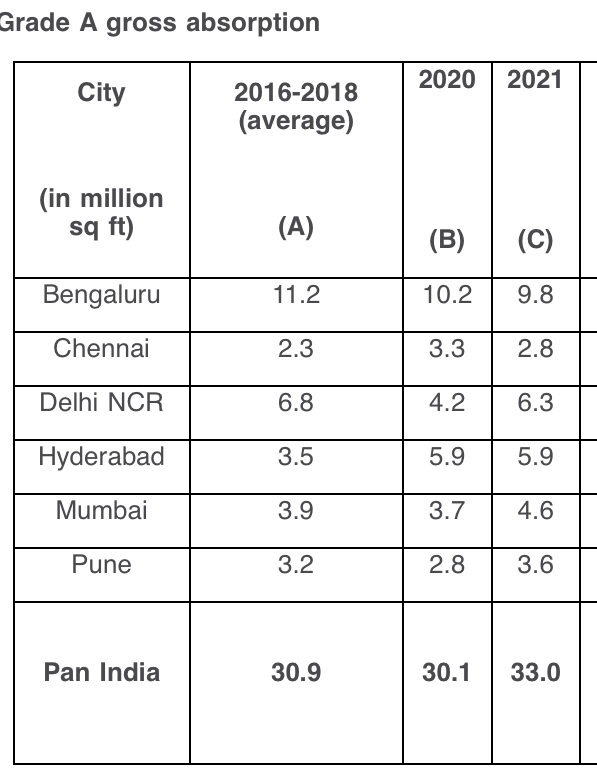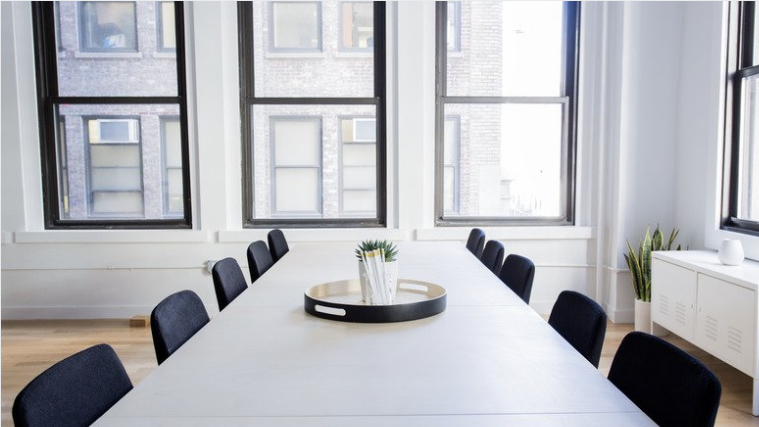2021 office leasing surpassed 2016-2018 average by 7%; Occupancy improved in key office districts of the top 3 cities.
By Varun Singh
Overall office gross absorption across the top six cities was at about 33 million sq feet, 10% higher compared to 2020, as per Colliers. Pan-India absorption during the year surpassed the annual gross absorption during 2016-2018 by 7%, signalling a strong revival in occupier confidence. Occupancy levels rose in prominent office micro markets across the top 3 cities at the end of 2021 from Q3 2021, led by a gradual revival in demand and fewer occupier exits.
Overall office space absorption is reviving and growing better-than-expected. On a city level, all cities, except Bengaluru and Delhi-NCR have surpassed the annual average absorption of 2016-2018. Hyderabad had seen strong recovery gains in 2020 and maintained its streak in 2021 as well. It was followed by Chennai and Mumbai which gained significant scale during the year. This is attributable to a strong fourth quarter, building on the momentum witnessed during the previous quarter of the year.
For instance, submarkets such as NCR’s MG Road, Mumbai BKC and Bengaluru’s SBD and Whitefield saw higher occupancy QoQ after a gap of at least 6 quarters. At the same time, total pan-India vacancy levels stood at 18.5%, a merely 40-basis point increase from Q3 2021.

In terms of new supply, the year 2021 saw 35 million sq feet of supply, almost at similar levels of 2020 as developers exercised ‘wait-and-watch’ and aligned new supply in response to market demand.
“Office occupancy is likely to rise in prominent office districts with quality grade A stock. Occupiers have already started preferring next-generation offices. In tune with this, we expect supply in 2022 to be around 35-38 million sq feet, 4% higher than 2021 levels.” says Vimal Nadar, Senior Director and Head of Research, Colliers India.
Leasing by start-ups up 56% in top 3 cities
In the top three cities, start-ups leased about 2.2 million sq feet of space during 2021, a 56% rise from 2020. The biggest spurt was seen in Delhi-NCR where start-ups leased office spaces in Gurgaon largely. This comes at a time when India saw the 42 start-ups becoming unicorns – the highest ever.
Flex spaces expanding across peripheral and suburban locations
Flex spaces expanded at a fast pace this year led by occupiers’ hybrid and decentralised work plans. During the year flex spaces leased about 4.8 million sq feet of space, a 60% rise YoY. Flex space leasing accounted for 15% of the leasing, compared to 9% share last year. Bengaluru accounted for maximum flex space leasing, followed by Hyderabad and Pune.
Operators are leasing space for new centers in suburban and peripheral locations as occupiers explore and adopt the decentralised way of working with hub and spoke-style offices, aligning with business continuity plans.
Delhi-NCR leasing up 50% led by demand for next-gen offices
Delhi NCR registered a 50% increase in leasing activity in 2021 on a YoY basis. Gurugram accounted for almost 64% share in leasing activity as many firms relocated to better quality buildings in upcoming micro markets such as Golf Course Extension Road and also centralized locations like Cyber City and MG Road. Recently delivered buildings are witnessing greater traction as occupiers consolidate their portfolios in Grade A buildings with better wellness standards. A similar trend is seen in other cities where occupiers are exploring next-generation offices to move into as developers and occupiers are committed to future-proof office spaces.
Also Read: South Cities’ Office Vacancies Rise in H1 FY22 Despite High Net Absorption









